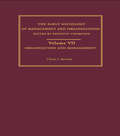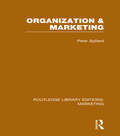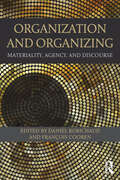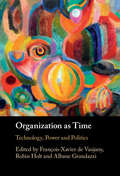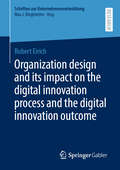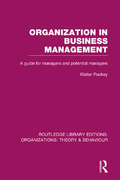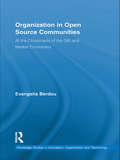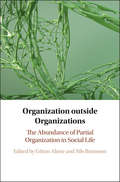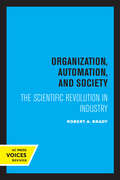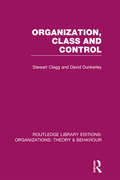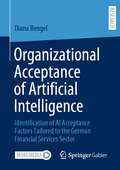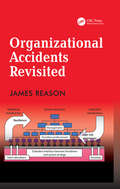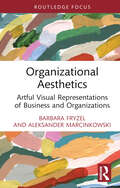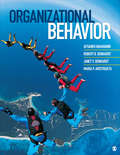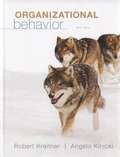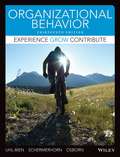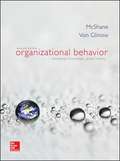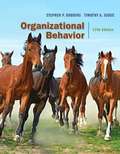- Table View
- List View
Organization and Management: Selected Papers
by Chester I. BarnardBarnard was prompted by Vilfredo Pareto's seminal four volume work Mind and Society to apply his theories of sociology to management studies. Barnard's study of interaction between people in economic settings was contentious in that he concluded that human behaviour within these settings is largely non-economic and instead approaches ritualistic symbolism.
Organization and Marketing (Routledge Library Editions: Marketing)
by Peter SpillardTaking as its starting point the nature of marketing tasks, this book draws on organizational theories and makes its own contribution to generate insights and understanding about some of the concerns that need to be deal with if marketing success is to be achieved. The book surveys developments in the study of organizations, and considers how organizations can be adapted to better serve the needs of marketing.
Organization and Organizing: Materiality, Agency and Discourse
by François Cooren Daniel RobichaudRecipient of the '2013 Top Edited Book Award', by the Organizational Communication Division of the National Communication Association (USA) This timely collection addresses central issues in organizational communication theory on the nature of organizing and organization. The unique strength of this volume is its contribution to the conception of materiality, agency, and discourse in current theorizing and research on the constitution of organizations. It addresses such questions as: To what extent should the materiality of texts and artifacts be accounted for in a process view of organization? What part does materiality play in the process by which organizations achieve continuity in time and space? In what sense do artifacts perform a role in human communication and interaction and in the constitution of organization? What are the voices and entities participating in the emergence and stabilization of organizational reality? The work represents scholarship going on in various parts of the world, and features contributions that overcome traditional conceptions of the nature of organizing by addressing in specific ways the difficult issues of the performative character of agency; materiality as the basis of the iterability of communication and continuity of organizations; and discourse as both textuality and interaction. The contributions laid out in this book also pay tribute to the work of the organizational communication theorist James R. Taylor, who developed a view of organization as deeply rooted in communication and language. Contributors extend and challenge Taylor’s communicative view by tackling issues and assumptions left implicit in his work.
Organization and Strategy at Millennium (A)
by Julie M. Wulf Scott WaggonerThis case examines Millennium's strategic and organizational responses to the rapid evolution of the biopharmaceutical industry. In the early 2000s, as Millennium's competitive advantage in early-stage research slipped away and its losses mounted, founder and CEO Mark Levin moved the firm downstream away from research and towards drug development and commercialization, while narrowing horizontal breadth from over a dozen therapeutic classes to just three. In 2005, Levin hired Deborah Dunsire from Novartis as CEO to lead Millennium's continuing transformation. Students are asked to put themselves in the shoes of incoming CEO Dunsire and to provide organizational recommendations to execute the new strategy.
Organization and Strategy at Millennium (B)
by Julie M. Wulf Scott WaggonerThis case examines Millennium's strategic and organizational responses to the rapid evolution of the biopharmaceutical industry. In the early 2000s, as Millennium's competitive advantage in early-stage research slipped away and its losses mounted, founder CEO Mark Levin moved the firm downstream away from research and towards drug development and commercialization, while narrowing horizontal breadth from over a dozen therapeutic classes to just three. In 2005, Levin hired Deborah Dunsire from Novartis as CEO to lead Millennium's continuing transformation. Students are asked to put themselves in the shoes of incoming CEO Dunsire and to provide organizational recommendations to execute the new strategy.
Organization as Time: Technology, Power and Politics
by Robin Holt de Vaujany, François-Xavier Albane GrandazziThe bulk of Management and Organization Studies deals with time as organization. Time is performed, organized, enacted, and as such is a locus of power. In this edited book, we stress the importance of organization as time. Time is an organizing force. The happening and becoming of collective activity, its technologies, its images, keep empowering, dominating or (more rarely) emancipating the fragile and ephemeral subjectivities of our world. The turn to digitality in all aspects of contemporary life has made the organizing power of time more pervasive than ever. How to describe organization as time? How to explore the relationship between becoming, duration, images, events, non-events or historicity and their relationships with power and emancipation? These are the rich and varied challenges seized by this book by a team of leading scholars interested in time and temporality in the context of management and organization.
Organization design and its impact on the digital innovation process and the digital innovation outcome (Schriften zur Unternehmensentwicklung)
by Robert EirichThe book has the objective to demystify the hyper-complex world of organization design and digital innovation. It shows how organization design as a management discipline can help organizations to better master digital innovation challenges. At the same time, it discusses how organization design frameworks need to be further developed to successfully act as a driver for innovation in a digital world. While the digital age brings tremendous new opportunities, it also brings the specific challenge that companies' organization designs must be adjusted. This book shows how companies organize for innovation in the digital world by presenting thirteen practical cases from various industries.
Organization in Business Management: A Guide for Managers and Potential Managers (Routledge Library Editions: Organizations)
by Walter PuckeyThis book is written primarily for junior management and discusses some key issues including: the increasing role of technology in business and management individual and group dynamics communication
Organization in Open Source Communities: At the Crossroads of the Gift and Market Economies (Routledge Studies in Innovation, Organizations and Technology)
by Evangelia BerdouThis book contributes new insights into the organization of free/open source (F/OS) software communities by examining the links between learning, division of labour and commercialization, demonstrating the need for a synthesis of work on both community organization and cooperation to understand F/OS community dynamics. These aspects are examined in the light of detailed case studies of the GNOME and KDE projects. This book offers an innovative theoretical framework, a critical assessment of various methodologies for examining the organisation of F/OS communities, and a typology of commercial involvement in F/OS. The analysis reveals the diversity and evolution of F/OS communities and their connections with other socio-economic networks and institutional practices. The insights afforded by the book have implications for future research and the design and implementation of open source efforts.
Organization outside Organizations: The Abundance of Partial Organization in Social Life
by Göran Ahrne Nils BrunssonThe book explores how various social settings are partially organized even when they do not form part of a formal organization. It also shows how even formal organizations may be only partially organized. Professors Göran Ahrne and Nils Brunsson first established the concept of partial organization in 2011 and in doing so opened up a ground-breaking new field of organizational analysis. An academic community has since developed around the concept, and Ahrne and Brunsson have edited this collection to reflect the current state of inquiry in this burgeoning subject and to set an agenda for future research. Its chapters explain how organization is a salient feature in many social settings, including markets, interfirm networks, social movements, criminal gangs, internet communication and family life. Organization theory is much more relevant for the understanding of social processes than previously assumed. This book provides a new understanding of many social phenomena and opens up new fields for organizational analysis.
Organization, Automation, and Society: The Scientific Revolution in Industry
by Robert A. BradyThis title is part of UC Press's Voices Revived program, which commemorates University of California Press’s mission to seek out and cultivate the brightest minds and give them voice, reach, and impact. Drawing on a backlist dating to 1893, Voices Revived makes high-quality, peer-reviewed scholarship accessible once again using print-on-demand technology. This title was originally published in 1961.
Organization, Class and Control (Routledge Library Editions: Organizations)
by Stewart Clegg David DunkerleyIn this volume the authors develop a systematic and chronologically based critique of the major concepts, figures and schools in organization. Themes discussed include: the development of scientific management and the responses of Gramsci and Lenin to it the meaning of Mayo and the Human Relations School the development of typological systems and contingency models of the organization key concepts of goals, environment and technology.
Organization: Aligning Stars and Strategy
by Jay W. Lorsch Thomas J. TierneyIn professional service firms, where power and influence are more widely distributed than in traditional corporate hierarchies, decisions about organization and strategy go hand in hand. This chapter suggests that firms are more successful in aligning their stars and strategies when their leaders approach these decisions about structure and governance systematically, as parts of a larger, integrated whole.
Organizational Acceptance of Artificial Intelligence: Identification of AI Acceptance Factors Tailored to the German Financial Services Sector
by Diana BengelThe book investigates the determinants which are influencing the acceptance of artificial intelligence (AI) in an organizational context, focusing on the German financial services industry. An AI-specific acceptance model is being developed based on technology acceptance models as well as being enriched with practical insights from industry experts. Ultimately, the acceptance of artificial intelligence is influenced by multiple, interrelated variables, which can be classified into five major dimensions: organizational, individual, financial, technological and societal factors.
Organizational Accidents Revisited
by James ReasonManaging the Risks of Organizational Accidents introduced the notion of an ’organizational accident’. These are rare but often calamitous events that occur in complex technological systems operating in hazardous circumstances. They stand in sharp contrast to ’individual accidents’ whose damaging consequences are limited to relatively few people or assets. Although they share some common causal factors, they mostly have quite different causal pathways. The frequency of individual accidents - usually lost-time injuries - does not predict the likelihood of an organizational accident. The book also elaborated upon the widely-cited Swiss Cheese Model. Organizational Accidents Revisited extends and develops these ideas using a standardized causal analysis of some 10 organizational accidents that have occurred in a variety of domains in the nearly 20 years that have passed since the original was published. These analyses provide the ’raw data’ for the process of drilling down into the underlying causal pathways. Many contributing latent conditions recur in a variety of domains. A number of these - organizational issues, design, procedures and so on - are examined in close detail in order to identify likely problems before they combine to penetrate the defences-in-depth. Where the 1997 book focused largely upon the systemic factors underlying organizational accidents, this complementary follow-up goes beyond this to examine what can be done to improve the ’error wisdom’ and risk awareness of those on the spot; they are often the last line of defence and so have the power to halt the accident trajectory before it can cause damage. The book concludes by advocating that system safety should require the integration of systemic factors (collective mindfulness) with individual mental skills (personal mindfulness).
Organizational Aesthetics: Artful Visual Representations of Business and Organizations (ISSN)
by Barbara Fryzel Aleksander MarcinkowskiOrganizational Aesthetics attempts to reconstruct artful representations of the organizational world and businesspeople. It looks at organizations and management through the eyes of artists, painters, and photographers and decodes meanings contained in artistic messages, grasping the aesthetic perceptions of the world of management and organization. Paintings and photos are analysed using qualitative methods from the social sciences as well as from the art analysis tradition. The novelty of the presented approach rests in the original method of parallel dialogues, taking place both in the institutional sphere and between co-authors. The institutional aspect covers a practical, business perspective and extends the narrow framework of a single discipline. It complements academic rigour with elements of digression and free conversation, revealing a variety of nuances for which conventional research paradigms do not always allow. Readers will receive a proposal on how to integrate diff erent approaches to organizational analysis stemming from artistic, managerial, and academic experiences.
Organizational Alignment Exercise
by John J. Gabarro Michael BeerPresents an overview of a method for diagnosing and developing an organization's capability to achieve its goals and implement its strategy, with exercises for application. A rewritten version of an earlier exercise.
Organizational Alignment, Performance, and Change in Professional Service Firms
by John J. GabarroThis note describes the relationship between organizational alignment and performance in professional service firms and how to use McKinsey 7S Alignment to diagnose a firm's or practice's alignment, identify misalignments and determine how to bring about the changes needed to re-align.
Organizational Alignment: The 7-S Model
by Jeffrey L. BradachPresents the 7-S framework. This framework offers managers a tool for diagnosing problems in their organizations and for proposing corrective courses of action. May be used with cases that deal with organizational alignment.
Organizational Behavior
by Robert B. Denhardt Janet V. Denhardt Afsaneh Nahavandi Dr Maria P. AristiguetaOrganizational Behavior is a unique text that thoroughly explores the topic of organizational behavior using a strengths-based, action-oriented approach while integrating important topics such as leadership, creativity and innovation, and the global society. Authors Afsaneh Nahavandi, Robert B. Denhardt, Janet V. Denhardt, and Maria P. Aristigueta focus on the interactions among individuals, groups, and organizations to illustrate how various organizational behavior topics fit together. This text challenges students to develop greater personal, interpersonal, and organizational skills in business environments, as well as utilize their own strengths and the strengths of others to achieve organizational commitment and success.
Organizational Behavior
by Angelo Kinicki Robert KreitnerIn its tradition of being an up-to-date, relevant and user-driven textbook, Kreitner and Kinicki's approach to organizational behavior is based on the authors' belief that reading a comprehensive textbook is hard work; however, the process should be interesting and sometimes even fun. The authors' commitment to continuous improvement makes complex ideas understandable through clear and concise explanations, contemporary examples, a visually appealing photo/art program, and/or learning exercises. The authors respond to user feedback by ensuring the text covers the very latest OB research and practices.
Organizational Behavior
by Mary Uhl-Bien Richard Osborn John Schermerhorn<p>In today's rapidly changing organizations, anything is possible. With the right personal skills and a strong foundation in research and theory, your students can shape their own future and the future of their organization. Now revised to address the recent changes in the workplace, Schermerhorn, Hunt, and Osborn`s Organizational Behavior, Ninth Edition sets the context of the course within a framework of personal and organizational transformation, while retaining its solid base of theory and application. <p>Reflecting the increasing demands of the global economy, advancements in technology, and the fallout from continuing ethics scandals, the new Ninth Edition prepares students to face the future workplace with confidence. Special features focus on Ethics and Social Responsibility, People and Technology, Culture and the Global Workforce, and Leaders on Leadership throughout the book. As in the previous edition, the Ninth Edition includes the integrated OB Skills Workbook with many Cases for Critical Thinking, Experiential Exercises, and Self-Assessments.</p>
Organizational Behavior
by Steven Lattimore McShane Mary Ann Von GlinowOrganisational Behavior, 7e by McShane/Von Glinow helps everyone make sense of Organizational Behavior, and provides the conceptual tools to work more effectively in the workplace. This author duo continue the trailblazing innovations that made previous editions of Organizational Behavior recognised and adopted by the new generation organisational behavior (OB) instructor. <p><p> Organisational Behavior, 7e is written in the context of these emerging workplace realities. This edition explains how emotions are the foundation of employee motivation, attitudes, and decisions; how social networks generate power and shape communication patterns; how self-concept influences individual behavior, team cohesion, and leadership; and how adopting a global mindset has become an important employee characteristic in this increasingly interconnected world. This book also presents the reality that organizational behavior is not just for managers; it is relevant and valuable to anyone who works in and around organizations.
Organizational Behavior
by Talya BauerTwo leading researchers in Management, Talya Bauer and Berrin Erdogan, bring you a new Organizational Behavior textbook that bridges the gap between theory and practice with a distinct experiential approach. On average, a worker in the USA will change jobs 10 times in 20 years. In order to succeed in this type of career situation, individuals need to be armed with the tools necessary to be life-long learners. To that end, this book is not be about giving students all the answers to every situation they may encounter when they start their first job or as they continue up the career ladder. Instead, this book gives students the vocabulary, framework, and critical thinking skills necessary to diagnose situations, ask tough questions, evaluate the answers received, and to act in an effective and ethical manner regardless of situational characteristics. Often, students taking OB either do not understand how important knowledge of OB can be to their professional careers, or they DO understand and they want to put that knowledge into practice. Organizational Behavior by Bauer and Erdogan takes a more experiential angle to the material to meet both of those needs. The experiential approach can be incorporated in the classroom primarily through the OB Toolbox. This feature brings life to the concepts and allows students to not only see how the OB theories unfold, but to practice them, as well.
Organizational Behavior (Seventeenth Edition)
by Stephen P. Robbins Timothy A. JudgeFor undergraduate and graduate courses in Organizational Behavior. Help Students Better Understand Their Behavioral and Interpersonal Skills Long considered the standard for all organizational behavior textbooks, Organizational Behavior provides the research you want, in the language you can understand. This text continues its tradition of making current, relevant research come alive for readers. The Seventeenth Edition has been thoroughly updated to reflect the most recent research and business events within the field of organizational behavior worldwide, while maintaining its hallmark features-clear writing style, cutting-edge content, and intuitive pedagogy. There's a reason why Robbins's textbooks have educated millions of individuals and have been translated into twenty languages-and it's because of a commitment that provides the kind of engaging, cutting-edge material that helps readers understand and connect with organizational behavior. Also Available with MyManagementLabTM MyManagementLab is an online homework, tutorial, and assessment program designed to work with this text to engage students and improve results. Within its structured environment, students practice what they learn, test their understanding, and pursue a personalized study plan that helps them better absorb course material and understand difficult concepts. NOTE: You are purchasing a standalone product; MyManagementLab does not come packaged with this content. If you would like to purchase both the physical text and MyManagementLab search for: 0134437861/ 9780134437866 Organizational Behavior Plus MyManagementLab with Pearson eText -- Access Card Package Package consists of: 013410398X / 9780134103983 Organizational Behavior 0134182189 / 9780134182186 MyManagementLab with Pearson eText--Access Card--for Organizational Behavior
